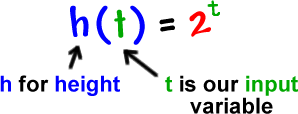Here's the situation:
Your spaceship has crashed on an unknown planet. You and your crew encounter a drooling, carnivorous alien monster. As you can guess, this is not good. It gets worse. While you are cowering in a cave, trying not to cry "mommy" in front of your crew, your science officer is able to chart the monster's growth over several hours' time. She comes back to you with her report (and minus one arm). The news is grim... With each hour that passes, the monster doubles in size (specifically, his height.) (She also said that the monster's stomach was making those growly-hungry noises.)
If we assume that the monster is 1 foot tall at birth, what formula would describe the growth of the monster?
Well, let's figure it out. The best thing to do to figure out things like this is to make a chart of data. You can usually find a pattern that will lead to the formula!
| TIME ( t ) | HEIGHT IN FEET | ||||
| |||||
| |||||
| |||||
| |||||
| |||||
See a pattern yet? | |||||
. |
| ||||
|
| ||||
. | |||||
|
| ||||
We can even rewrite the first line of the table like this so the pattern sticks:
| At birth: |
We can write
![]()
Using function notation, our official formula is

Now, you can figure out the monster's height at any time!